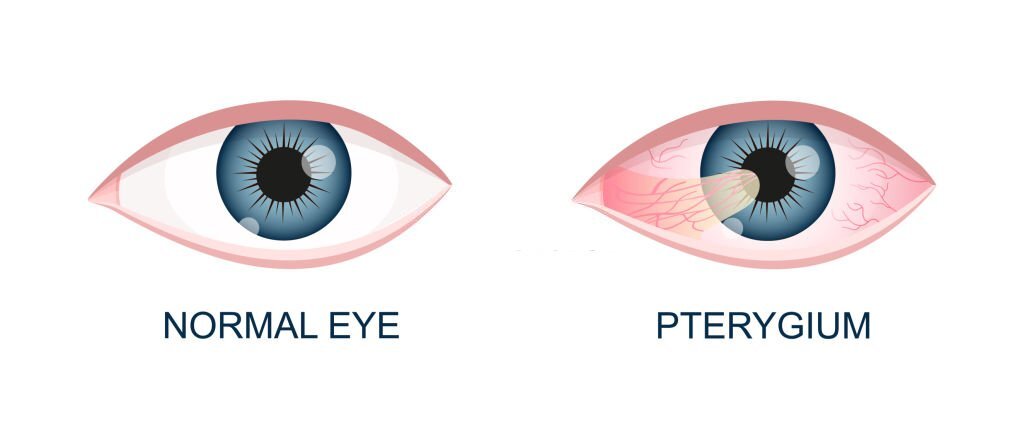Shree Ramakrishna Netralaya (Vashi)
Shah Signature, Above Starbucks, Sector 17,
Vashi, Navi Mumbai - 400705
+91 98198 60879 | [email protected]
Appointment Times
Monday - Saturday :
11:00 am to 07:00 pm
Dr. Vijay Shetty Eye Specialist
Shah Signature, Above Starbucks, Sector 17,
Vashi, Navi Mumbai - 400705
+91 98198 60879 | [email protected]
Monday - Saturday :
11:00 am to 07:00 pm

Shah Signature, Above Starbucks, Sector 17,
Vashi, Navi Mumbai - 400705 +91 98198 60879 | [email protected]
Monday - Saturday :
11:00 am to 07:00 pm


Pterygium is a condition where there is a fleshy growth arising from conjunctiva (white transparent portion) growing on to cornea. This is usually seen in elderly who are exposed to lot of sunlight exposure. Pterygia are not harmful, but they can cause eye irritation and changes in vision.
In the early stages, a pterygium may not be very noticeable. It is also unlikely to cause any discomfort or changes in vision. If the pterygium continues to grow, however, it may become more visible. The growth will typically appear fleshy and triangular. It may be red, pink, or yellow.
Different types of eyedrops may be prescribed to lubricate your eyes, reduce inflammation, or increase tear production.
The exact cause of pterygium isn’t known. This is usually seen in elderly who are exposed to lot of sunlight exposure. In the early stages it causes a cosmetic disfigurement and in later stage may affect the vision. It occurs more often in people who live in warm climates and spend a lot of time outdoors in sunny or windy environments. People whose eyes are exposed to certain elements on a regular basis have a higher risk of developing this condition. These elements include:
Diagnosing a pterygium is straightforward. We may diagnose this condition based on a physical examination using a slit lamp. This lamp allows us to see your eye with the help of magnification and bright lighting. If we need to do additional tests, they may include:
Visual acuity test. This test involves reading letters on an eye chart.
Corneal topography. This medical mapping technique is used to measure curvature changes in your cornea.
Photo documentation. This procedure involves taking pictures to track the growth rate of the pterygium.
Redness in pterygium can be reduced to some extent with drops. However a definitive treatment is surgery where in the pterygium mass is removed and replaced with conjunctival graft fixed with glue.
If possible, avoid exposure to environmental factors that can cause a pterygium. You can help prevent the development of a pterygium by wearing sunglasses or a hat to shield your eyes from sunlight, wind, and dust. Your sunglasses should also provide protection from the sun’s ultraviolet (UV) rays. If you already have a pterygium, limiting your exposure to the following can slow its growth. Other factors involved are wind, dust, pollen, smoke.
Avoiding these conditions can also help prevent pterygiums from coming back if you’ve had any removed.

Avoid direct and long exposure to sunlight. And wear sunglasses or hats whenever necessary to shield your eyes from sunlight, wind, and dust.

Your sunglasses should also provide protection from the sun’s ultraviolet (UV) rays. If you already have a pterygium, limiting your exposure to the following can slow its growth

Avoiding these conditions can also help prevent pterygiums from coming back if you’ve had any removed.
Comparing pingueculae and pterygia
Pingueculae and pterygia are types of growths that can form on your eye. The singular term for pterygia is pterygium. These two conditions share a few similarities, but there are also notable differences between them.
Pingueculae and pterygia are both benign and grow near the cornea. They’re both linked to exposure to the sun, wind, and other harsh elements.
However, pterygia don’t look like pingueculae. Pterygia have a flesh-colored appearance and are round, oval, or elongated. Pterygia are more likely to grow over the cornea than pingueculae. A pinguecula that grows onto the cornea is known as a pterygium.